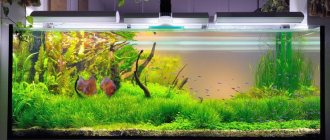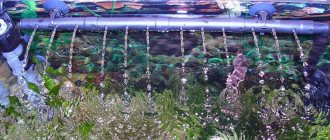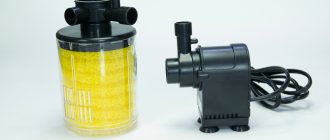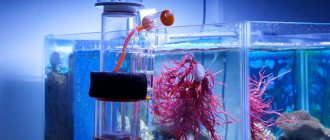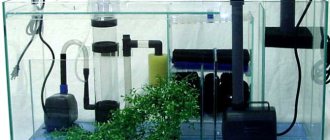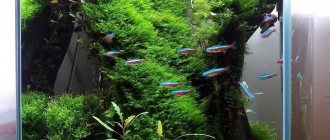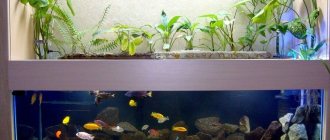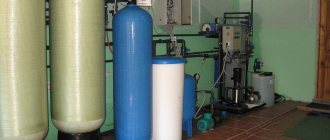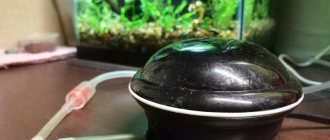3.6
(11)
All natural bodies of water are cleaned naturally. A closed ecosystem independently maintains the necessary balance. Rivers and lakes contain large colonies of beneficial bacteria, as well as various natural filter materials. Aquariums also require filtration to maintain cleanliness. However, it is often carried out exclusively mechanically.
Of course, this type of cleaning is also quite useful, but if we talk about efficiency, the best option is an internal or external biofilter. An aquarist should not rack his brains, since nature has long thought of everything for him. The main thing is to simply implement the natural biological process at home, which is relatively easy to do.
Why do you need a biofilter?
There are several types of cleaning. The most common is mechanical, but there are also chemical and biological types. Scientists believe that it is the latter type that is considered the most important and necessary.
This is explained by the fact that in every aquarium there is organic matter left behind by fish and other inhabitants. Decomposition of feces, food residues, plant leaves and gases exhaled by animals provoke the release of ammonia. It poses a huge danger to all living creatures living in the home underwater world.
At a concentration of 0.2 mg/l, ammonia will kill all fish, and for some varieties the dangerous indicator is 10 times less. Accordingly, the aquarist needs to carefully monitor such biological processes and avoid situations where animals may suffer.
Ammonia can be dealt with in various ways. The simplest is regular water changes. They are held weekly, but not more often. Such procedures are very stressful for the inhabitants of the aquarium and, in addition, they can upset the fragile balance of the home ecosystem.
Therefore, the best way to deal with ammonia is through beneficial colonies of bacteria that oxidize it, thus converting it into nitrites and then into nitrates. The latter, of course, in certain concentrations can also cause harm to animals, but they are also a nutrient for natural plants.
This is the principle of biological filtration. It takes place in several stages:
- Fish leave behind waste products;
- Feces, food scraps and leaves decompose, releasing ammonia;
- Bacteria process them;
- The resulting nitrate is absorbed by living plants.
Bacteria independently form in the aquarium during the nitrogen cycle. They live in water, on walls, on decorations. They help maintain the necessary balance, but sometimes it happens that these colonies are not enough, and then ammonia still accumulates, poisoning all the animals. In this case, the task of the aquarist is to multiply microorganisms so that they can cope with high biological loads.
We recommend reading the article: How to choose lighting for an aquarium
Biofiltration to eliminate unpleasant odors
The main area of application of biological filtration devices is air purification from unpleasant odors. The microbiological breakdown of odor-producing substances into carbon dioxide and water occurs at ambient temperature, so there is no need to use additional energy or additives. Therefore, the production costs of this process are very negligible. In many areas, biofiltration is becoming an integral part of the technical equipment of production.
Thousands of biofiltration devices are used in Europe to eliminate unpleasant odors from a wide variety of emission sources. Unbearable odor problems are often found in the vicinity of wastewater treatment plants, landfills, foundries, breweries, food processing plants, animal housing, waste treatment plants, agricultural enterprises and slaughterhouses. Biofiltration is the least expensive and most reliable method for eliminating unpleasant odors - its efficiency reaches 99%.
What does it consist of and how does it work?
A biofilter for an aquarium is an original device that is easier to assemble yourself, at home. Of course, there is equipment from manufacturers. However, regardless of type, they perform several types of cleaning. Most often this is a biological and mechanical type, but aquarists also additionally purchase chemical fillers (activated carbon, zeolite).
That is, in such devices the biofilter is only one of the components, albeit the predominant one due to its importance. However, in some cases, only biological filtration is needed. Then it’s easier to assemble the device yourself.
There are several varieties of such filters, differing in housing type, fillers and other characteristics. But, regardless of this, they all have a simple principle of operation:
- Take a container;
- Fillers are poured into it (soil, expanded clay, foam rubber, ceramic rings, foam glass, etc.). They necessarily have pores in which colonies of beneficial bacteria populate over time;
- A hose with a working element that creates a flow is connected to this body (most often a compressor is used);
- Water flows through the biofilter fillers, and at this moment the microorganisms living in the container process hazardous compounds;
- Water that is already purified and safe for fish enters the aquarium, and the remaining nitrates in it are absorbed by the planted living plants.
We recommend reading the article: Why does the water in the aquarium become cloudy?
Chemical cleaning
In aquarium practice, chemical filtration is primarily understood as sorption. Depending on the type of sorption, various adsorbents are used - bodies capable of absorbing a substance with their (usually highly porous) surface, and chemical absorbers that bind a certain substance, entering into a chemical reaction with it.
A separate group is represented by ion exchange sorbents, passing through which the solution gives them ions of one type and takes away an equivalent amount of ions of another type.
zeolite
The most common chemical filtration is using activated carbon as an adsorbent. Some minerals belonging to the zeolite group, synthetic ion exchange resins and peat are used as chemical fillers. Ion exchange resins and zeolites absorb nitrates, ammonia, phosphates and some other substances, and instead release harmless ions of chlorine, sodium, and sulfates. Peat contains a rich set of amino acids and tannins. Therefore, its use as a filler slightly reduces the pH value, while simultaneously enriching the water with various biologically active substances, so necessary for the inhabitants of “black waters”.
Granulated peat
Sterilization of water can also be classified as chemical filtration. The main methods in aquarium practice are ultraviolet irradiation and ozonation.
Types of filter materials
Modern biological filters use a variety of fillers. Each has certain characteristics and, accordingly, advantages and disadvantages. Aquarists mainly use:
Foam rubber or synthetic winterizer . Perhaps they are the most common. This is explained by their versatility and effectiveness. First of all, they provide mechanical cleaning. They retain feces and various solid impurities. But at the same time, bacteria also settle in them. They are usually installed in internal biofilters. However, this option is not suitable for large aquariums, since it is not able to cope with a large load and gets clogged quite quickly;
Bioceramics . Also quite a popular filler. Often present in the basic configuration of external canister-type filters. Their properties make them optimal for outdoor equipment. They disperse oxygen perfectly, and in addition, colonies of bacteria easily settle in them. In addition, they do not carry out mechanical cleaning, and accordingly, contaminants do not linger in them, and therefore they need to be washed extremely rarely;
Plastic . You can often find filter materials such as plastic balls in stores. They have a ribbed surface. Microorganisms grow in it, and thanks to the cutting of the water flow, all these pores are saturated with oxygen, necessary for invisible biological cleaners;
Glass . Recently, porous glass has become in demand. It is manufactured using special technology. Thanks to it, the output is balls 8-12 mm in diameter. Bacteria quickly appear in them, processing dangerous compounds in aquarium water.
Exhaust air requirements
The most important prerequisites for the functioning of biofilters are:
- Maintaining favorable temperature conditions (+5°C - +55°C).
- Irrigation of the filter layer to prevent it from drying out.
- Preventing the formation of cracks and cracks in the filter layer.
- The substances to be cleaned must be water-soluble.
- The substances to be cleaned must be biodegradable.
- Regular supply of nutrients to the habitat of microorganisms.
Popular brands of biofilters
If desired, the aquarist does not have to make his own filter. He has the opportunity to simply purchase ready-made equipment that will ensure high-quality cleaning of the aquarium. It is impossible to list all the options available on the market, so it is better to focus on a few of the most popular brands.
Tetra EX
Perhaps every aquarist has heard about this manufacturer at least once. Its products are known for their high quality, because the German company carefully controls production processes.
Filters from Tetra are no exception, and they have been in demand among lovers of underwater flora and fauna for quite some time. This equipment provides high-quality cleaning of aquariums with a volume of 60-500 liters. As a rule, ceramic rings and biological balls are used as standard.
Before connecting, be sure to read the instructions. The assembly diagram will be indicated there. We recommend that you pre-rinse all fillers under the tap (they probably contain dust and small fragments formed during transportation).
In order for the equipment to work, you must independently create a flow draft. This is done using a special pumping button located on top of the case.
JBL
Another well-known German manufacturer specializing in economical filters. All of their biological filter models use bioceramics. In them, water enters from above, passes through mechanical cleaning fillers, and then returns back through the biological substrate.
The equipment is prepared in the same way as with Tetra.
Aquael
The Polish company is known for producing budget filters. But, despite their low price, they are distinguished by high performance and reliability. The model range includes equipment for aquariums with a volume of 100-700 liters. The most powerful devices have two pumps and four hoses (for drawing in and releasing water), thanks to which it is possible to achieve a stronger flow and mixing of water. Ceramic rings or biological balls are used as fillers.
Main characteristics of filters
Pump power
This is the volume of water pumped through the filler per unit of time, measured in the usual l/h. The pump power is indicated here, without taking into account the filler resistance. This is an important nuance, because... even clean filler reduces pump performance.
Over time, the filler becomes clogged and productivity may drop to a minimum. This is how we came to the first indicator of filter quality: the time during which the filter’s performance drops.
According to my observations, the best in this regard are ADA, Eheim, Aquael. Many people are outraged by the extremely high prices of ADA products, but, for example, their external filter can not be washed for years and this will not affect its operation or the condition of the aquarium.
The power of the external filter pump is selected from the conditions of ~ 100 l/h per 10 every 10 liters of water. It turns out that a 60 liter aquarium requires a filter with a pump capacity of ~ 600 liters per hour.
Remember a simple relationship: the flow force from the filter outlet has dropped - it’s time to rinse the filter media. Under no circumstances should it fall to zero. Do not allow the water flow from the filter to decrease significantly.
If your aquarium population does not change frequently, simply note the time during which the filter becomes so dirty that it needs to be washed (power drop to 30%, but no more), and service the filter after each interval of this time. I think this is the best solution.
Possibility of adjusting flow power
Some filters have this option (Aquael fan - 3, Eheim professional 5e, AQUAEL Ultramax 1000) - to reduce too much flow from the filter.
This is usually done by moving the valve inside the filter structure, which is impractical.
This valve only increases the resistance of the pump and can lead to the effect of cavitation - the collapse of bubbles formed due to a local decrease in the diameter through which water passes.
Cavitation leads to destruction of the impeller (roughly speaking, the filter rotor blade).
Avoid a filter with this feature or simply don't use it.
Filter canister volume
Also an important characteristic of the filter. Filler is placed in the canister/flask and the more, the better. Inspect the canister before purchasing.
Now it is very fashionable to make the maximum number of compartments, plastic additional cells, which, of course, is done for ease of maintenance of the aquarium, but eats up the useful volume of the canister.
So, from a volume of 6 liters there may be only 3-4 liters left for the filler itself. JBL CristalProfi greenline filters stand out with large cells.
I prefer filters without additional cells and compartments, so that the entire filter space is used exclusively for filler (Eheim Classic version).
But if flasks are installed inside the filter, proper operation of the filter is only possible with them. Those. If you purchased a filter with compartments, you must use them.
Availability of UV lamp
Sterilizing water using a UV lamp is quite a useful thing, but with a lamp power of several Watts, it loses any meaning.
So, this is more of a “why not” addition. Therefore, you can safely use the filter without a UV lamp. If it is really needed, the lamp built into the filter will not be enough.
Filters with UV lamps:
Aquael unifilter 500 UV
Sera UVC-Xtreme 1200
Filler included
Please pay attention to this, because... It is the filler that plays a necessary role in the operation of the filter; without it, it is just an empty container that distills water. If the filler is not included with the filter, it must be purchased separately. The same Eheim Classic series filters can be supplied with or without Eheim Substrate Pro filler.
Availability of taps on hoses
They greatly simplify aquarium maintenance work. If the taps are not included in the kit, then buy them right away; during the moments of service they will give you pleasant moments. Buy taps not Chinese, but German Eheim, detachable, two pairs at once for each hose.
When my Chinese taps were closed, they diverged in different directions. Imagine if they were connected to an aquarium? Everything would be on the floor. And that client has a 600 liter aquarium.
- Internal filters are equipped with a short hose that fits over the outlet of the filter. It is used for the filter to suck in air from outside. It can be used as needed; This is not a mandatory component of the design. Very often you can see the use of Aquael Fan series filters just together with an air suction hose.
It may not be obvious to some, but a filter is a permanent aquarium equipment. It should not be on a timer or only turn on when necessary. The filter should always work.
Do-it-yourself biofilter for an aquarium
In terms of its functions, a homemade biofilter will not be inferior to analogues from well-known manufacturers, if you approach the manufacture responsibly and select the right materials. In general, there are several options for biological filters.
Bowl in a glass
The simplest materials available in every aquarist’s home are suitable for this filter. You will need a small plastic bottle, a PVC tube with a diameter matching the size of the neck, soil (fine pebbles up to 5 mm are best), padding polyester and a compressor.
The manufacturing process itself goes as follows:
- The bottle is cut (at the upper border of the label). The main thing is that the upper half passes into the lower half with difficulty;
- In the resulting bowl (half with a neck) we make about 10 holes with a diameter of 3-4 mm;
- We insert the tube into it. It is important that it fits tightly. If there is a gap, then you need to seal it with silicone glue. The tube itself should be slightly higher in height than the bottom half of the bottle, and it is important that it does not reach the bottom;
- Pour pebbles into the finished body in a layer of 5-6 cm and lay padding polyester on it;
- The hose from the compressor is placed in the tube and secured there;
- Actually, the filter is ready. We throw it into the water, turn on the compressor, and check its functionality.
This is an extremely simple and quite effective option. The air will pass through the tube and go up. The substrate will be saturated with oxygen, and water will flow through the holes to the bottom of the tube and then into the aquarium.
Bottle filter
In principle, this option is similar to the previous one, but it also has its own differences. This time you will need a 1.5 liter plastic bottle, substrate, foam rubber, clamps, compressor, hose and sprayer.
The assembly diagram is not particularly complicated:
- Using an awl, we make holes in the bottom of the bottle;
- Next, it is wrapped with foam rubber and tightened with clamps;
- Approximately half of this container is filled with substrate;
- We run the hose from the compressor along with the sprayer on top;
- We place the finished structure in the aquarium, turn it on, and check it.
The size of the bottle is not important, but you should select it based on the volume of the aquarium and the power of the compressor. The operating principle is extremely simple. Flow occurs due to oxygen. Air along with water is forced out through the neck of the bottle, and from below the liquid passes through the holes made.
Thus, colonies of bacteria will settle in the filler, which, due to the flow, will absorb harmful substances.
Technological basics
The technological basis is essentially biochemical oxidation and, at the same time, the decomposition and transformation of materials by bacteria, fungi and yeast into substances that are harmless and do not have unpleasant odors.
The prerequisites are that the hazardous materials are water-soluble, biodegradable and non-toxic to microorganisms.
The rapidly growing population of microorganisms living on the filter layer uses volatile organic compounds contained in polluted air for their own metabolic processes. Decomposition occurs under aerobic conditions and sufficient oxygen. The latter is ensured by its sufficient content directly in the air. It is necessary to use exhaust air saturated with water vapor, since the filter material must be moist.
Conclusion
Before making a biofilter for a septic tank, be sure to select the device itself, find out whether it is suitable for your treatment plant, select a suitable location, prepare a pit and carry out all stages of installation. A biological filter is an installation that improves the quality of drainage cleaning by up to 98%; it accelerates the development and reproduction of microorganisms, which helps to increase the efficiency of the station. If you install a biological filter system, you will not need to equip filtration fields. All sewage wastewater will be treated mechanically, as well as through anaerobic and aerobic processes.
Installation goals
First, let's remember how a septic tank works.
- Domestic wastewater enters the primary settling tank , where it undergoes separation: in the absence of mixing of wastewater by the incoming flow, heavy fractions settle to the bottom, while lighter fractions form a dense crust on the surface.
- The settled water can be disposed of >; however, it is often further purified in one way or another. After settling, the wastewater retains the smell of sewage, and contamination of groundwater when discharged onto the terrain will be inevitable. The list of additional treatment methods includes one or more secondary settling tanks, an aeration chamber and, finally, soil filtration.
Scheme of the simplest two-chamber septic tank.
Please note: to be precise, soil purification is the final stage in the operation of almost any septic tank. The wastewater passes through the drainage and soil layer, during which organic residues are processed by anaerobic bacteria.
So, the filter systems of local septic tank treatment facilities include:
- Filter wells . In them, treated wastewater is gradually absorbed into the soil; For additional mechanical cleaning and to prevent silting, drainage is used - a backfill of gravel or crushed stone.
- A filtration field for a septic tank with significant productivity or on soils with low water absorption is an alternative to a well . Drainage pipes are laid in a thick layer of bedding; In this case, wastewater is filtered through the ground, but over a much larger area.
- An infiltrator for a septic tank is an alternative to a drainage pipe, a special case of a filtration field . The device looks like an inverted trough and ensures unhindered flow of wastewater to a large absorbent surface.
- Finally, to further purify settled wastewater before it enters the drainage, an additional mechanical filter is often installed . The purpose of its use is to prevent large suspended solids and debris that have passed through all the settling tanks from entering the drainage. Digging out a clogged drainage pipe system and flushing it out is really a very tedious and thankless task.
How to launch correctly
The aquarist’s task before moving in is to speed up the process of reproduction of beneficial bacteria for the fish and the aquarium itself. There is a traditional and perhaps the simplest method: adding dirt from the bottom of the old aquarium to the new one. Along with this substance, living and beneficial microorganisms will appear.
But not everyone has several home ponds, so the way out is to purchase bacteria at a pet store, which has everything for aquariums. The appearance of cloudy water is a sign that protozoa have begun to reproduce and oxidize nitrates.
Some novice aquarists make a mistake during the first start - they change the water. You should not pour out the liquid with bacteria, because after a few days the water will become attractively clear again. Within two weeks after launch, the protozoa actively reproduce. Usually, powders will retain entire sets, and not just one type, because nitrites and nitrates require different organisms.
To avoid having to resort to restarting (eviction of fish, purifying the water and adding new “purifiers”), it is recommended to perform a slow colonization. There is no need to rush into settling, because the longer the bacteria dominate the aquarium, the more favorable the environment for the fish will be.
Operating principle
In such a filter, all the work is done by the bacteria in it. Therefore, the filler itself, until it is inhabited by microorganisms, only performs mechanical water purification, collecting fine dirt. Bacteria that perform cleansing functions can be of two types:
- Nitrifying bacteria (Oxidize ammonia to hydroxylamine, and then to nitrite and nitrate).
- Nitrobacteria (Feed on nitrites, after which they transform them into nitrates).
Thus, we can conclude that the operating principle of all biological filters is based on creating comfortable conditions for bacteria, which will break down ammonia, which is dangerous for fish, and help establish ideal biological balance in the tank.
Sources
- https://vse-o-vode.ru/technology/biofiltry-dlya-ochistki-stochnyx-vod/
- https://gamma-septic.ru/biofiltryi-dlya-ochistki-stochnyih-vod
- https://oseptikah.ru/ochist/34-biofiltr-dlya-septika-svoimi-rukami
- https://oseptikah.ru/dop-elementy/35-filtr-dlya-septika
- https://vivoz-gbo.ru/septiki/biofiltr-dlya-septika
- https://OtepleiVode.ru/kanalizatsiya/septiki/biofiltr-dlya-septika.html
- https://kanalizaciyam.ru/biofiltr-dlya-septika.html
- https://iseptick.ru/kanalizaciya/septiki/biofiltr-dlya-septika-svoimi-rukami.html
- https://plavnika.net/akvarium/komplektujushhie/filtr/vidy-f/biofiltr.html
[collapse]
What it is
The loud name “biofilter” hides just one of the chambers of a multi-chamber septic tank, in which optimal conditions have been created for the proliferation of bacterial colonies.
Which ones exactly?
- The chamber contains filling with a large surface area. In industrially produced deep cleaning stations, special plastic products are used for this purpose, which in appearance resemble... ordinary dishwashers.
- In addition, the vital activity of aerobic (oxygen-absorbing) bacteria requires saturation of wastewater with air. That is why in the notorious deep biological treatment stations the biofilter chamber is aerated: air bubbles are pumped to its bottom by a compressor.
Please note: when there is a lack of oxygen, anaerobic bacteria, for obvious reasons, dominate among the cultures growing in the biofilter. Their ability to assimilate organic matter is much more modest than that of aerobic ones; however, they also contribute to wastewater treatment.
Minuses
The use of biofilters also has certain disadvantages, namely:
- an increase in the cost of equipment, that is, septic tanks with installed biofilters are more expensive than conventional ones. If the filter is mounted separately, then it must be purchased additionally;
- if an installation with a biofilter is used, then it is necessary to monitor the quality of the wastewater; bleach and other substances that can destroy bacteria should not enter the drainage;
- the installation must operate constantly; during long periods of downtime, bacteria deprived of “food” may die.
